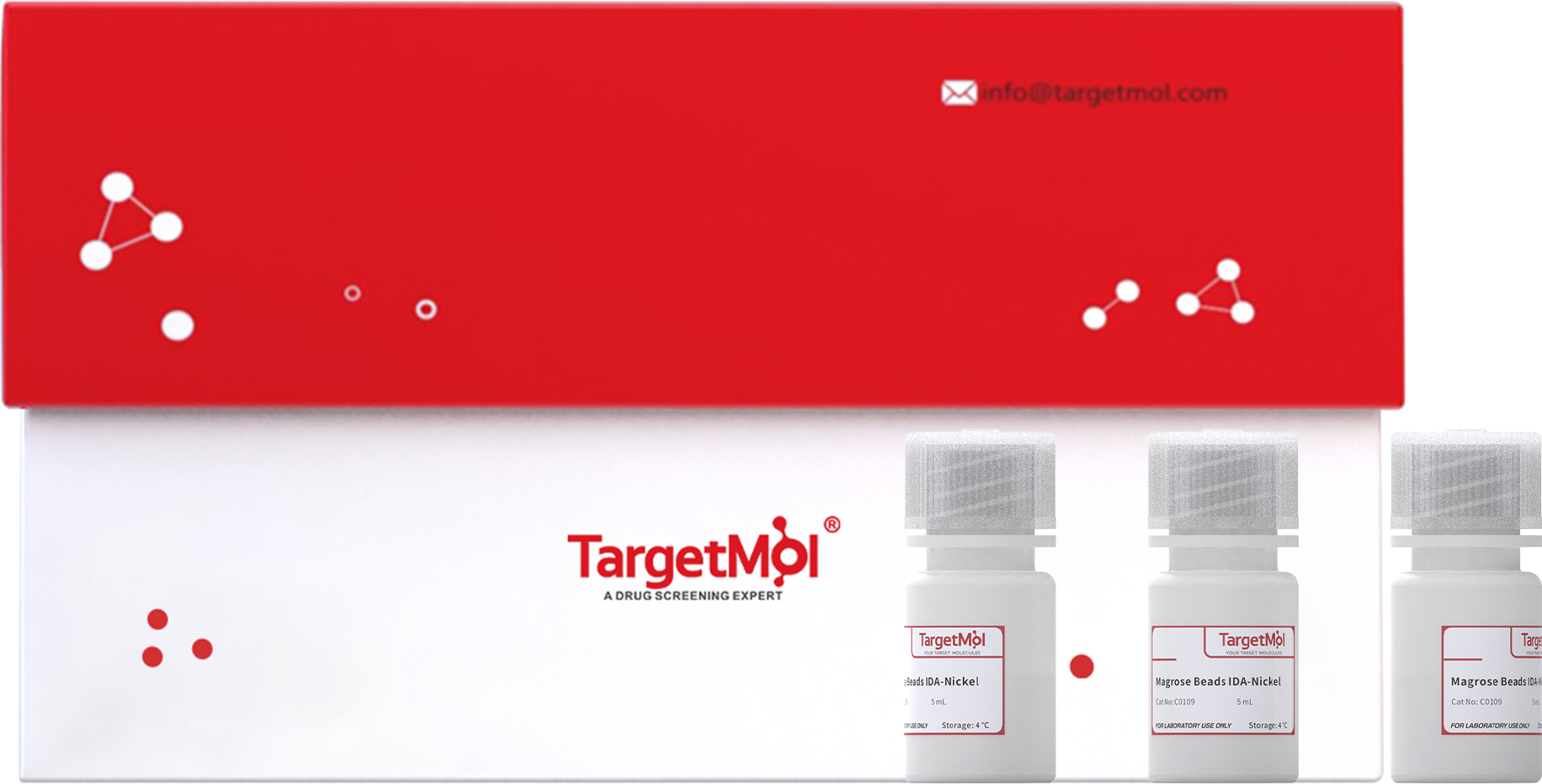- Remove All
 Your shopping cart is currently empty
Your shopping cart is currently empty


Magrose Beads IDA-Nickel
Based on magnetic agarose microspheres, the His-tag protein purification beads activate and couple iminodiacetic acid (IDA) or nitrilotriacetic acid (NTA). Then, they chelate respectively nickel (Nickel) and cobalt (Cobalt) ions. IDA has a relatively strong binding affinity with His-tag proteins and has a higher loading capacity but lower specificity, while NTA has the opposite characteristics. Nickel and Cobalt ions have different properties at a binding capacity of target proteins and non-specific adsorption. Nickel magnetic beads have a higher protein loading capacity but slightly lower purity (90%), while Cobalt magnetic beads have a slightly lower protein loading capacity but higher purity (95%). Users can select different types of His-tag protein purification beads based on different purposes.
| Pack Size | Price | Availability | Quantity |
|---|---|---|---|
| 5 mL | $45 | In Stock | |
| 25 mL | $160 | In Stock | |
| 50 mL | $285 | In Stock |
 Comparison
Comparison
| Products | IDA-Ni (C0109) | IDA-Co (C0110) | NTA-Ni (C0111) |
|---|---|---|---|
| Material | Agarose | Agarose | Agarose |
| Bead Size | 30-150 μm | 30-150 μm | 30-150 μm |
| Chelated Metal Ion | Nickel ion | Cobalt ion | Nickel ion |
| Density of Metal Ion | 30-50 μmol/mL (100% Beads) | 30-50 μmol/mL (100% Beads) | 30-50 μmol/mL (100% Beads) |
| Protein Binding Capacity | 30-40 mg/mL (100% Beads) | 20-30 mg/mL (100% Beads) | 40-50 mg/mL (100% Beads) |
| pH | 3-11 | 3-11 | 3-11 |
| Temperature | 2-30 ℃ | 2-30 ℃ | 2-30 ℃ |
| Suspension Concentration | 10% (v/v) Bead Suspension | 10% (v/v) Bead Suspension | 25% (v/v) Bead Suspension |
| Storage Buffer | 20% (v/v) Ethanol | 20% (v/v) Ethanol | 20% (v/v) Ethanol |
 Product Features
Product Features
- Crude samples can be directly purified without pretreatment, significantly reducing purification time.
- One-step purification yields high amounts and high purity of the target protein.
- The concentration and volume of the target protein can be freely adjusted.
- High stability in parallel operations facilitates high-throughput and large-scale protein purification.
- The magnetic beads are reusable and easy to regenerate.
 Application
Application
- Suitable for the purification of soluble His-tag protein that secretion or intracellular expression by bacterium, yeast, insect and mammalian cells
- Suitable for purification of denatured protein (for inclusion body proteins, denature first and then carry out purification operation).
 Operating Instructions
Operating Instructions
1. Preparation of Buffer:
The following are commonly used buffer compositions for most His-tag protein purification.
Note: It is recommended to filter the buffer using a 0.22 μm or 0.45 μm membrane filter for sterilization before use.
1)Binding Buffer:20 mM Phosphate Buffer,500 mM NaCl,5~50 mM Imidazole,pH7.4.
2)Washing Buffer:20 mM Phosphate Buffer,500 mM NaCl,50~100 mM Imidazole,pH7.4.
3)Elution Buffer:20 mM Phosphate Buffer,500 mM NaCl,500 mM Imidazole,pH7.4.
2. Protein Sample Processing:
1)E. coli, yeast and other intracellular proteins: a) dilute the expressed cells with an appropriate amount of Binding Buffer. b) add protease inhibitors (e.g., 1 mM PMSF or C0001 protease inhibitor Cocktail). c) resuspend the cells and lyse them by sonication on ice to obtain a crude protein sample. If the sample is too viscous, add an appropriate amount of nuclease and incubate on ice for 30 minutes to degrade nucleic acids. Centrifuge the sample if necessary.
2)Intracellular proteins in animal cells: a) take an appropriate amount of animal cells, wash once with an appropriate amount of PBS, and remove the supernatant. b) resuspend with an appropriate amount of Binding Buffer containing 1% (v/v) Triton X-100 or 1% (v/v) NP-40. c) add protease inhibitors and incubate on ice for 10 minutes to obtain a crude protein sample.
3)Extracellular expression proteins: dilute the extracellular supernatant with an equal volume of Binding Buffer to obtain a crude protein sample.
3. Pretreatment of Magnetic Beads:
Calculate the amount of magnetic beads based on the target protein yield and the magnetic bead capacity.
For example, using E. coli to express a target protein. 2 g of wet cell can be obtained from 500 mL fermentation broth. The target protein is estimated to be 10-20 mg. Thus, 5 mL of bead suspension is needed for target protein purification.
The operation steps are as follows:
1)Mix the His-tag protein purification beads thoroughly by using a vortex mixer. Transfer 5 mL of magnetic bead suspension to a 15 mL centrifuge tube with a pipette. Place the centrifuge tube in a magnetic separator and stand for 1 minute. Perform magnetic separation. Finally remove the supernatant and then take off the centrifuge tube.
2)Add 5 mL of Binding Buffer to the centrifuge tube, and gently invert the tube several times to resuspend the beads. Perform magnetic separation and remove the supernatant. Repeat the washing step twice.
4. Binding of Magnetic Beads to Target Protein:
1)Suspend 2 g of wet cell in 10 mL of Binding Buffer and lyse the cells to obtain the crude protein sample. Add the sample to the centrifuge tube containing pretreated magnetic beads and place on a vortex mixer for 15 seconds.
2)Place the centrifuge tube on a rotating mixer and mix at room temperature for 20-30 minutes. Alternatively, mix at 2-8°C for 1 hour to prevent target protein degradation.
3)Perform magnetic separation on the centrifuge tube and transfer the supernatant to a new tube for further analysis. Proceed with the washing steps.
5. Washing of Magnetic Beads:
1)Add 10 mL of Washing Buffer to the centrifuge tube containing the magnetic beads. Gently invert the tube several times to resuspend the beads. Perform magnetic separation and transfer the washing solution to a new tube for sample analysis. Repeat the washing step once.
2)To avoid contamination of the target protein by non-specific binding on the tube wall, add 10 mL of Washing Buffer to the tube containing the magnetic beads to resuspend the beads Transfer the suspension to a new tube. Perform magnetic separation, and transfer the supernatant to the washing solution tube.
6. Elution of Target Protein:
1)Determine the elution volume and adjust the concentration of target proteins. Add 2-10 mL of Elution Buffer to the centrifuge tube. Gently invert the tube several times to resuspend the beads. Perform magnetic separation, and collect the elution solution in a new centrifuge tube to obtain the purified target protein sample.
2)To ensure complete elution of the target protein, repeat the above step again.
7. Post-treatment of Magnetic Beads:
1)Add 5 mL of Elution Buffer to the centrifuge tube containing beads. Gently invert the tube several times to resuspend the beads. Perform magnetic separation, and remove the supernatant. Repeat this step twice.
2)Add 5 mL of ddH2O to the centrifuge tube. Gently invert the tube several times to resuspend the beads. Perform magnetic separation, and remove the supernatant. Repeat this step twice.
3)Add Storage Buffer to the beads to a total volume of 5 mL. Store at 2-30°C (or 2-8°C for long-term storage), and it can be used for the same protein purification next time.
8. Regeneration of Magnetic Beads:
After more than three consecutive uses, the binding capacity of beads may decrease significantly. It is recommended to regenerate the beads. The following steps describe the regeneration for 5 mL of 10% (v/v) bead suspension:
1)Reagents:
• Stripping Buffer:20 mM Sodium Phosphate,500 mM NaCl,100 mM EDTA, pH 7.4
• Beads Washing Buffer(optional):0.5 M NaOH,2 M NaCl
• Recharge Buffer:100 mM NiSO4 / CoCl2 (toxic)
• Storage Buffer:20%(v/v)Ethanol
2)Perform magnetic separation on the bead suspension. Remove the supernatant, and add 5 mL of ddH2O. Gently invert the tube several times to resuspend the beads. Perform magnetic separation and remove the supernatant.
3)Add 5 mL of Stripping Buffer, and gently invert the tube several times to resuspend the beads. Mix at room temperature for 5 minutes. Perform magnetic separation, and remove the supernatant. Repeat this step once.
4)Add 5 mL of ddH2O, and gently invert the tube several times to resuspend the beads. Perform magnetic separation, and remove the supernatant. Repeat this step twice.
5)Alkaline treatment: Add 5 mL of Beads Washing Buffer, and gently invert the tube several times to resuspend the beads. Mix at room temperature for 5 minutes. Perform magnetic separation, and remove the supernatant.
6)Add 5 mL of ddH2O, and gently invert the tube several times to resuspend the beads. Perform magnetic separation, and remove the supernatant. Repeat this step 3-5 times to obtain neutral washing solution.
7)Add 5 mL of Recharge Buffer, and gently invert the tube several times to resuspend the beads. Mix at room temperature for 5 minutes. Perform magnetic separation, and remove the supernatant.
8)Add 5 mL of ddH2O, and gently invert the tube several times to resuspend the beads. Perform magnetic separation, and remove the supernatant. Repeat this step at least 4 times to ensure complete removal of nickel ions.
9)Finally, add Storage Buffer to the beads to a total volume of 5 mL, and store at 2-30°C (or keep at 2-8°C for long-term storage).
9. Optimization of Protein Purification Process:
The above procedures are applicable for the purification of most His-tagged proteins.
Depending on the binding characteristics of the target protein with magnetic chelating beads, users can optimize the purification process to improve the purity of the target protein.
1)Methods to increase recovery rate of target protein:
• Reduce the concentration of imidazole in the sample solution and Binding Buffer.
• Add surfactants or other substances to the sample solution and other buffers.
• Add appropriate protease inhibitors to prevent degradation of target protein.
• Increase the amount of magnetic beads.
• Extend the incubation time between the protein and the beads.
• Extend the elution time or increase the number of elution steps.
2)Methods to increase target protein purity:
• Increase the concentration of imidazole and NaCl in the sample solution and Binding Buffer.
• Add surfactants or other substances to the sample solution and other buffers.
• Add appropriate protease inhibitors to prevent degradation of target protein.
• Extend the washing time and increase the number of washing steps.
• Elute the target protein with a gradient concentration of imidazole.
 Storage
Storage
Store at 4℃ for 2 years.
 Precautions
Precautions
- Avoid freezing the beads. Store in solution to prevent drying.
- The average magnetic separation time should be longer than 1 min each time.
- Ensure uniform suspension by fully shaking the storage tube before use. Avoid bubbles during operation.
- Use high-quality tips and test tubes to avoid sample loss due to adhesion.
- If the solution is too viscous to resuspend the beads by inverting the centrifuge tube, use pipetting or a brief vortex mix to fully resuspend the beads.
- Users can retain the supernatant based on practical needs removed after magnetic separation for sample analysis and process optimization.
- The product can be reused. It is recommended to regenerate the beads when the purification performance declines.
- When reusing the beads, it is recommended to purify the same type of protein. When purifying a different protein, please use new beads.
- The product is for R&D use only, not for diagnostic procedures, food, drug, household or other uses.
- Please wear a lab coat and disposable gloves.

Copyright © 2015-2025 TargetMol Chemicals Inc. All Rights Reserved.


